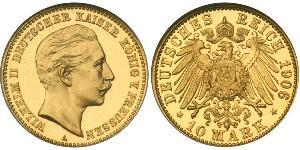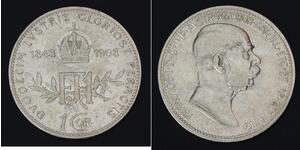2 Mark
1901, Prussia, Wilhelm II. Silver 2 Mark "Kingdom of Prussia Bicentennial" Coin. NGC MS-65!
Mint Year: 1901
Reference: KM-525.
Mint Place: Berlin (A)
Condition: Certified and graded by NGC as MS-65!
Denomination: 2 Mark - 200th Anniversary of the Kingdom of Prussia.
Material: Silver (.900)
Weight: 11,10gm
Diameter: 28mm
Obverse: Conjoined, armored and draped busts of Emperor Wilhelm II (helmeted) and Frederick I of Prussia (wreathed) left.
Legend: + FRIEDRICH I 1701 WILHELM II II 1901
Reverse: Crown of the German Empire above heraldic eagle of Germany with prussian shield at chest and star order.
Legend: DEUTSCHES REICH 1901 * ZWEI MARK *
The Kingdom of Prussia (German: Königreich Preußen) was a German kingdom that constituted the state of Prussia between 1701 and 1918. It was the driving force behind the unification of Germany in 1866 and was the leading state of the German Empire until its dissolution in 1918. Although it took its name from the region called Prussia, it was based in the Margraviate of Brandenburg. Its capital was Berlin.[6] Due to the fact that Brandenburg was the seat of power and prominent part of the entity, the state is also referred to as Prussia-Brandenburg or Brandenburg-Prussia and sometimes erroneously as the Kingdom of Brandenburg or the Kingdom of Nordmark.
Wilhelm II (German: Prinz Friedrich Wilhelm Viktor Albert von Preußen; English: Prince Frederick William Victor Albert of Prussia) (27 January 1859 – 4 June 1941) was the last German Emperor and King of Prussia (German: Deutscher Kaiser und König von Preußen), ruling both the German Empire and the Kingdom of Prussia from June 15, 1888 to November 9, 1918.
The German Emperor Wilhelm I died in Berlin on 9 March 1888, and Prince Wilhelm's father was proclaimed Emperor as Frederick III. He was already suffering from an incurable throat cancer and spent all 99 days of his reign fighting the disease before dying. On 15 June of that same year, his 29-year-old son succeeded him as German Emperor and King of Prussia.
Although in his youth he had been a great admirer of Otto von Bismarck, Wilhelm's characteristic impatience soon brought him into conflict with the "Iron Chancellor", the dominant figure in the foundation of his empire. The new Emperor opposed Bismarck's careful foreign policy, preferring vigorous and rapid expansion to protect Germany's "place in the sun." Furthermore, the young Emperor had come to the throne with the determination that he was going to rule as well as reign, unlike his grandfather, who had largely been content to leave day-to-day administration to Bismarck.
Early conflicts between Wilhelm II and his chancellor soon poisoned the relationship between the two men. Bismarck believed that William was a lightweight who could be dominated, and he showed scant respect for Wilhelm's policies in the late 1880s. The final split between monarch and statesman occurred soon after an attempt by Bismarck to implement a far-reaching anti-Socialist law in early 1890.

|
Posted by:
anonymous 2023-10-30 |
|
||
|
||
|
||
|
||
|
||
1 Corona Austria-Hungary (1867-1918) Silver Franz Joseph I ( ...
group has 25 coins / 17 prices
⇑

-600-300-W4YhwJflyaYAAAGLvHFTnYJn.jpg)

-300-150-wpQK_j7gfGcAAAE0axXJlmpq.jpg)
 Deutsch
Deutsch Русский
Русский Українська
Українська English
English Italiano
Italiano Français
Français Español
Español 汉语
汉语





-300-150-AeIKqUpY7NEAAAFhroEy54Nz.jpg)






